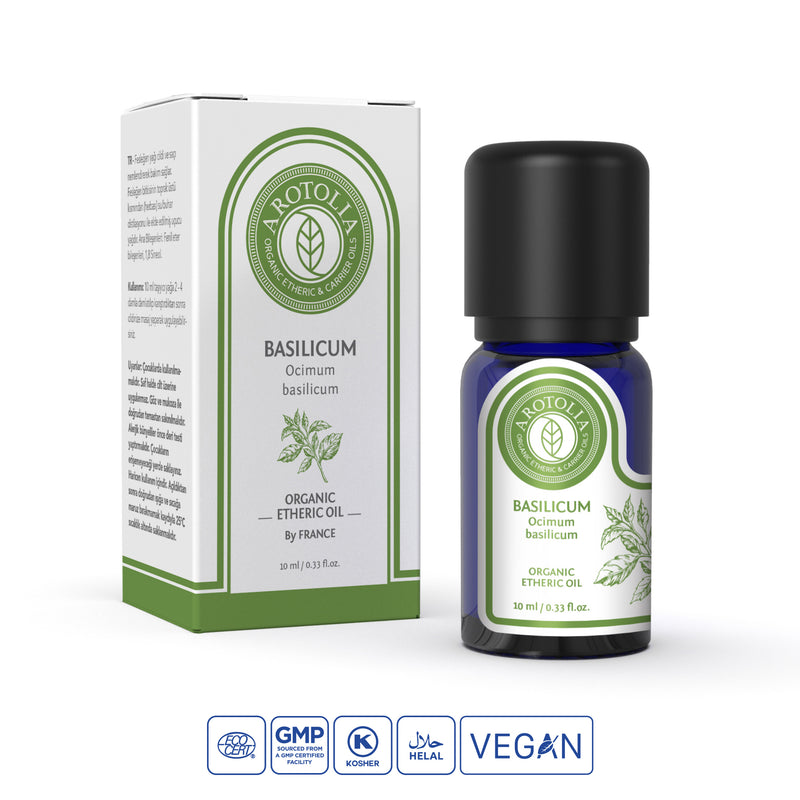
Basil Essential Oil
English name of the plant: Basil essential oil
Scientific name of the plant: Ocimum basilicum
Plant Family: Lamiaceae
Description: Obtained by water distillation from above-ground parts.
Color: Colorless
Smell: Sweet, herbaceous, licorice-like
Odor level: Medium
Note: Top
Composition: Linanol, eugenol, citronellol, limonene, cineole, borneol, pinene
Growing areas: Pacific islands, North and South America, tropical Asia and Africa, and Europe
It grows widely (especially in France, Italy, Bulgaria, Hungary and Egypt)
Compatible oils: Lavender, allspice, bergamot, cardamom, cedarwood, roman chamomile,
labdanum, coriander seed, grapefruit, clary sage, patchouli, tarragon,
sage, geranium, immortelle, juniper, lemon, manuka, marjoram, nioli, orange, oregano, palma
rosa,petitgrain,rosemary,sandalwood,ylang ylang
EFFECTS, AREAS OF USE AND HOW TO USE
-It has antiviral, antiseptic and antibacterial properties.
-Digestive aid, nausea and vomiting, abdominal pain, carminative, anti-cramp, appetite stimulant,
It is effective as a cough suppressant and for shortness of breath.
-It is calming, relaxing, encouraging and effective against depression.
-It is a stimulant in eliminating mental fatigue and strengthening concentration.
provides clarification.
-It is effective for headache, migraine, insomnia and nervous tension.
-It can be used for wound treatment, muscle, nerve and joint pain, and rheumatism complaints.
-For insect bites, 1-2 drops can be applied to the affected area.
WARNINGS
-It should not be used in people who are sensitive to plants of the Lamiaceae family.
-It is not safe to use during pregnancy, breastfeeding, children and infants.
-Should not be brought into contact with eyes.
-Should be kept out of reach of children.
Scientific name of the plant: Ocimum basilicum
Plant Family: Lamiaceae
Description: Obtained by water distillation from above-ground parts.
Color: Colorless
Smell: Sweet, herbaceous, licorice-like
Odor level: Medium
Note: Top
Composition: Linanol, eugenol, citronellol, limonene, cineole, borneol, pinene
Growing areas: Pacific islands, North and South America, tropical Asia and Africa, and Europe
It grows widely (especially in France, Italy, Bulgaria, Hungary and Egypt)
Compatible oils: Lavender, allspice, bergamot, cardamom, cedarwood, roman chamomile,
labdanum, coriander seed, grapefruit, clary sage, patchouli, tarragon,
sage, geranium, immortelle, juniper, lemon, manuka, marjoram, nioli, orange, oregano, palma
rosa,petitgrain,rosemary,sandalwood,ylang ylang
EFFECTS, AREAS OF USE AND HOW TO USE
-It has antiviral, antiseptic and antibacterial properties.
-Digestive aid, nausea and vomiting, abdominal pain, carminative, anti-cramp, appetite stimulant,
It is effective as a cough suppressant and for shortness of breath.
-It is calming, relaxing, encouraging and effective against depression.
-It is a stimulant in eliminating mental fatigue and strengthening concentration.
provides clarification.
-It is effective for headache, migraine, insomnia and nervous tension.
-It can be used for wound treatment, muscle, nerve and joint pain, and rheumatism complaints.
-For insect bites, 1-2 drops can be applied to the affected area.
WARNINGS
-It should not be used in people who are sensitive to plants of the Lamiaceae family.
-It is not safe to use during pregnancy, breastfeeding, children and infants.
-Should not be brought into contact with eyes.
-Should be kept out of reach of children.




